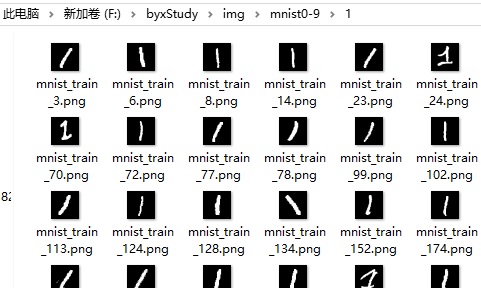②本地图片转TFRecord及opencv安装
Posted lc__________
tags:
篇首语:本文由小常识网(cha138.com)小编为大家整理,主要介绍了②本地图片转TFRecord及opencv安装相关的知识,希望对你有一定的参考价值。
之前我们对图片数据的读取是通过tensorflow的mnist类直接下载和加载mnist数据集。但是更多的时候,我们想通过本地的图片进行训练。
import input_data
mnist = input_data.read_data_sets('MNIST_data', one_hot=True)def _int64_feature(value):
return tf.train.Feature(int64_list=tf.train.Int64List(value=[value]))
def _bytes_feature(value):
return tf.train.Feature(bytes_list=tf.train.BytesList(value=[value]))
dirPath = "F:/byxStudy/img/mnist0-9/"
sess = tf.InteractiveSession()
init = tf.global_variables_initializer()
sess.run(init)
#保存tfrecords
tfrecord_filename = 'F:\\\\byxStudy\\\\img\\\\mnist0_9_train.tfrecords'
fileSubDirList = os.listdir(dirPath)
with tf.python_io.TFRecordWriter(tfrecord_filename) as writer:
# 遍历子文件夹
for fileSubDir in fileSubDirList:
fileSubDirSubDir = os.listdir(dirPath + fileSubDir + "/")
for filePath in fileSubDirSubDir:
image_value = tf.read_file(dirPath + fileSubDir + "/" + filePath)
img = tf.image.decode_jpeg(image_value, 1)
img = tf.image.resize_images(img, (28, 28), method=0)
pic2 = img.eval(session=sess)
image_raw = pic2.tostring()
example = tf.train.Example(
features=tf.train.Features(
feature=
'height': _int64_feature(pic2.shape[0]),
'width': _int64_feature(pic2.shape[1]),
'depth': _int64_feature(pic2.shape[2]),
'label': _int64_feature(int(fileSubDir)),
'image_raw': _bytes_feature(image_raw)
))
writer.write(example.SerializeToString()) 但是实际跑起来后发现程序运行的很慢。
通过调查得知,tensorflow运行的时候不要创建任何新的计算节点。
这样每一次迭代都会在graph里增加新的节点,导致memory leak,程序越来越慢,最后强行退出。
因此我想通过opencv对图像进行简单的预处理。opencv的安装过程很艰辛,我尝试了各种网上的办法,最终才得以实现,以下是我的尝试:
①通过pycharm直接安装cv2及opencv-python
②通过opencv官网
https://www.opencv.org/releases.html
下载安装opencv
并将..\\opencv\\build\\python\\2.7\\x64\\cv2.pyd文件复制粘贴到python安装目录..Lib\\site-packages下
③pip install opencv_python-3.4.0.12-cp36-none-win_amd64.whl
④安装VC++运行时环境,Visual C++ 2015 redistribution
⑤下载python-3.6.3-embed-amd64,并将python3.dll拷贝到python.exe目录下
⑥配置python环境变量
安装 opencv-contrib-python。
通过pip完成了安装!pip install opencv-contrib-python
但是实际跑起来后发现程序运行的很慢。
通过调查得知,tensorflow运行的时候不要创建任何新的计算节点。
这样每一次迭代都会在graph里增加新的节点,导致memory leak,程序越来越慢,最后强行退出。
因此我想通过opencv对图像进行简单的预处理。opencv的安装过程很艰辛,我尝试了各种网上的办法,最终才得以实现,以下是我的尝试:
①通过pycharm直接安装cv2及opencv-python
②通过opencv官网
https://www.opencv.org/releases.html
下载安装opencv
并将..\\opencv\\build\\python\\2.7\\x64\\cv2.pyd文件复制粘贴到python安装目录..Lib\\site-packages下
③pip install opencv_python-3.4.0.12-cp36-none-win_amd64.whl
④安装VC++运行时环境,Visual C++ 2015 redistribution
⑤下载python-3.6.3-embed-amd64,并将python3.dll拷贝到python.exe目录下
⑥配置python环境变量
安装 opencv-contrib-python。
通过pip完成了安装!pip install opencv-contrib-python
import cv2
import os
import tensorflow as tf
def _int64_feature(value):
return tf.train.Feature(int64_list=tf.train.Int64List(value=[value]))
def _bytes_feature(value):
return tf.train.Feature(bytes_list=tf.train.BytesList(value=[value]))
dir_path = "F:/byxStudy/img/mnist0-9/"
tfrecord_filename = 'F:\\\\byxStudy\\\\img\\\\mnist0_9_train.tfrecords'
dir_list = os.listdir(dir_path)
with tf.python_io.TFRecordWriter(tfrecord_filename) as writer:
# 遍历子文件夹
for sub_dir in dir_list:
sub_dir_list = os.listdir(dir_path + sub_dir + "/")
for filePath in sub_dir_list:
# 单通道的方式读取图片
# 中文目录无法加载图片
img = cv2.imread(dir_path + sub_dir + '/' + filePath, 0)
img = cv2.resize(img, (28, 28), interpolation=cv2.INTER_CUBIC)
image_raw = img.tostring()
example = tf.train.Example(
features=tf.train.Features(
feature=
'height': _int64_feature(img.shape[0]),
'width': _int64_feature(img.shape[1]),
'depth': _int64_feature(1),
'label': _int64_feature(int(sub_dir)),
'image_raw': _bytes_feature(image_raw)
))
writer.write(example.SerializeToString())以上是关于②本地图片转TFRecord及opencv安装的主要内容,如果未能解决你的问题,请参考以下文章